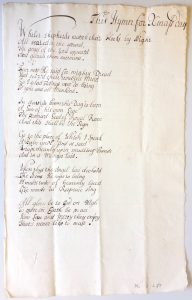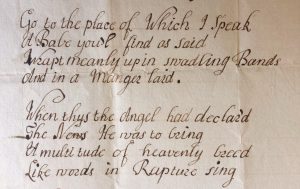December 8, 2016, by Kathryn Steenson
Singing from a different Hymn sheet
‘While Shepherds Watched their Flocks by Night’ is one of the best-known Christmas carols. It is based on the Annunciation to the shepherds, as described in the Gospel of St Luke. An angel appeared to the shepherds in the fields outside Bethlehem and told them of the birth of Jesus in a scene that has been depicted numerous times in art, music, and – if you count school nativity plays – drama.
Authorship is attributed to Nahum Tate (1652 – 30 July 1715), an Irish poet and England’s Poet Laureate who published a revised Psalter in 1700 in which the hymn appeared. The hymn’s history is quite important as it marked a turning point in the Church of England’s approach to religious music. ‘While Shepherds Watched their Flocks by Night’ was the first Christmas hymn to be approved by the Church of England, and it was rapidly adopted for use in services across the country. Prior to 1700, only the psalms could be sung in church services because most carols had roots in folk music and were considered inappropriately secular. Carols were still very popular and well-known, but with no ‘official’ version, there were many regional differences in the lyrics and tunes.
This version we have (Me 2 L 1/5) is, unfortunately, undated, but is probably from the 18th century. It was found among the papers of politician and antiquarian Charles Mellish (1737-1797). Although the sentiment is the same, it has some notable textual differences from the version usually sung and that written by Tate, not least of all the fact that it’s been titled ‘This Hymn for Xmas day’.
The fourth and fifth verses that you’re probably familiar with goes:
“The Heavenly Babe you there shall find / to human view displayed / all meanly wrapped in swathing bands / and in a manger laid
Thus spake the seraph and forthwith /appeared a shining throng / of angels praising God, who thus / addressed their joyful song”
Our version reads:
“Go to the place of which I speak / A babe you’ll find as said / Wrapt meanly up in swadling bands / And in a manger laid
“When thys the Angel had declared / The news he was to bring / A multitude of heavenly breed / Like words in rapture sing”
It would be intriguing to know how soon this version appeared after Tate’s and whether there were other variants in popular soon after the published edition.
This and many other rare books and manuscripts can be viewed in our Reading Room. Email us to make an appointment, or for general information see our website, follow us on Twitter @mssUniNott, or read our newsletter Discover. We will be closed from 22 December to 2 January inclusive.
Merry Christmas!



This is a rare piece! How lucky to have it! Did you compare with same church texts of that period?